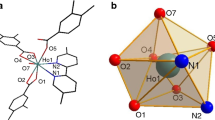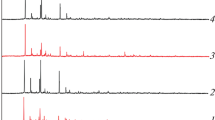Abstract
The modes of decomposition of a few rare earth metal formates and benzoates were studied by the use of DTA, DSC, TG and DTG techniques in air, nitrogen and vacuum. The volatile products and residues were identified. The activation energies of decompositions and the heat of reaction for transitions were calculated.
The decomposition of the rare earth metal formates gave carbon dioxide and water as their volatile products and the benzoates gave benzil and probably benzophenone in the case of lanthanum benzoate and biphenyl in the case of other rare earth metal benzoates, as their main volatile products, leaving the corresponding trioxides as their final residues.
Résumé
On a étudié la décomposition des formiates et benzoates de quelques terres rares par ATD, DSC, TG et TGD. On a identifié les produits volatils ainsi que les résidus. On a calculé les énergies d'activation des décompositions et la chaleur des réactions de transition.
Les formiates des terres rares donnent comme produits de décomposition volatiles de l'anhydride carbonique et de l'eau, tandis que, dans le cas du benzoate de lanthane, on obtient du benzyle et, probablement, du benzophénone. Les autres benzoates de terres rares fournissent du diphényle comme principal produit volatil. Les trioxydes respectifs forment le résidu final.
Zusammenfassung
Der Verlauf der thermischen Zersetzung einiger seltener Erdmetall-Formiate und -Benzoate wurde unter Anwendung der DTA, DSC, TG und DTG-Techniken studiert. Die flüchtigen Produkte und die Rückstände wurden identifiziert. Die Aktivierungsenergien der Zersetzungsvorgänge und die Reaktionswärmen der Übergänge wurden ermittelt.
Die Zersetzung der seltenen Erdmetall-Formiate ergab Kohlendioxid und Wasser als flüchtige Produkte, während die Benzoate — im Falle von Lanthan-benzoat Benzyl und wahrscheinlich Benzophenon, im Falle anderer seltener Erdmetall-benzoate Biphenyl als flüchtige Hauptprodukte ergaben. Die entsprechenden Trioxide verblieben als Rückstand.
Резюме
Методами ДТА, ДСК, ТГ и Д ТГ исследованы типы распада нескольких формиатов и бензоато в. Идентифицированы л етучие продукты и остатки. Дл я наблюдаемых превращений рассчит аны энергии активаци и распада и тепловой эффект реак ции. При распаде формиато в редкоземельных мет аллов образуются, в качеств е летучих продуктов, двуокись у глерода и вода, а при ра спаде бензоатов — бензил и, в озможно, бензофенон, в случае б ензоата лантана, и диф енил, в случае бензоатов дру гих редкоземельных металлов, — как их осно вные летучие продукт ы. Конечными продуктам и в остатке являются соо тветствующие триоки си.
Similar content being viewed by others
References
Bahoo et al., J. Indian Chem. Soc., 37 (1960) 594.
M. M. Steinberg et al., J. Phys. Chem., 66 (1962) 1737.
V. E. Plyuschev, L. M. Shkol'nikova andG. D. Kuz'netsova, Dokl. Akad. Nauk USSR, 160 (1965) 366.
V. V. Deshpande andE. B. Mizra, Proc. Chem. Symp., Chemistry and Metallurgy Comm. of the Dept. of Atomic Energy; Bhabha Atomic Research Center, Bombay-74, India, 1 (1970) 209.
C. V. Kavadia andH. B. Mathur, Indian Journal of Chemistry, 8 (1970) 638.
M. N. Ambrozhii andYu. A. Osipova, Zh. Neorgan. Khim., 3 (1958) 2716.
M. D. Taylor, C. P. Carter andC. I. Wynter, J. Inorg. Nucl. Chem., 30 (1968) 1503.
C. J. H. Schutte andK. Buds, Spectrochim. Acta, 20 (1964) 187.
J. A. Goldsmith andS. D. Ross, Spectrochim. Acta, 23 A (1967) 1909.
N. T. McDevitt andN. L. Baun, Spectrochim. Acta, 20 (1964) 799.
H. H. Horowitz andG. Metzger, Anal. Chem., 35 (1963) 1464.
S. R. Dharwadkar andM. D. Karkhanavala, in “Thermal Analysis” Vol. 2 (Edited by R. F. Schwenker Jr. and P. D. Garn) Academic Press, New York, 1969.
Du Pont Thermal Analysis Manual, 1971.
Author information
Authors and Affiliations
Additional information
Abstracted in part from a thesis submitted by R. Panayappan to the Graduate School of Howard University in partial fulfillment of the requirement for the degree of Ph. D.
Rights and permissions
About this article
Cite this article
Taylor, M.D., Panayappan, R. Modes of decomposition of rare earth metal formates and benzoates, enthalpies of transition, and activation energies of decomposition. Journal of Thermal Analysis 6, 673–688 (1974). https://doi.org/10.1007/BF01911787
Received:
Issue Date:
DOI: https://doi.org/10.1007/BF01911787




